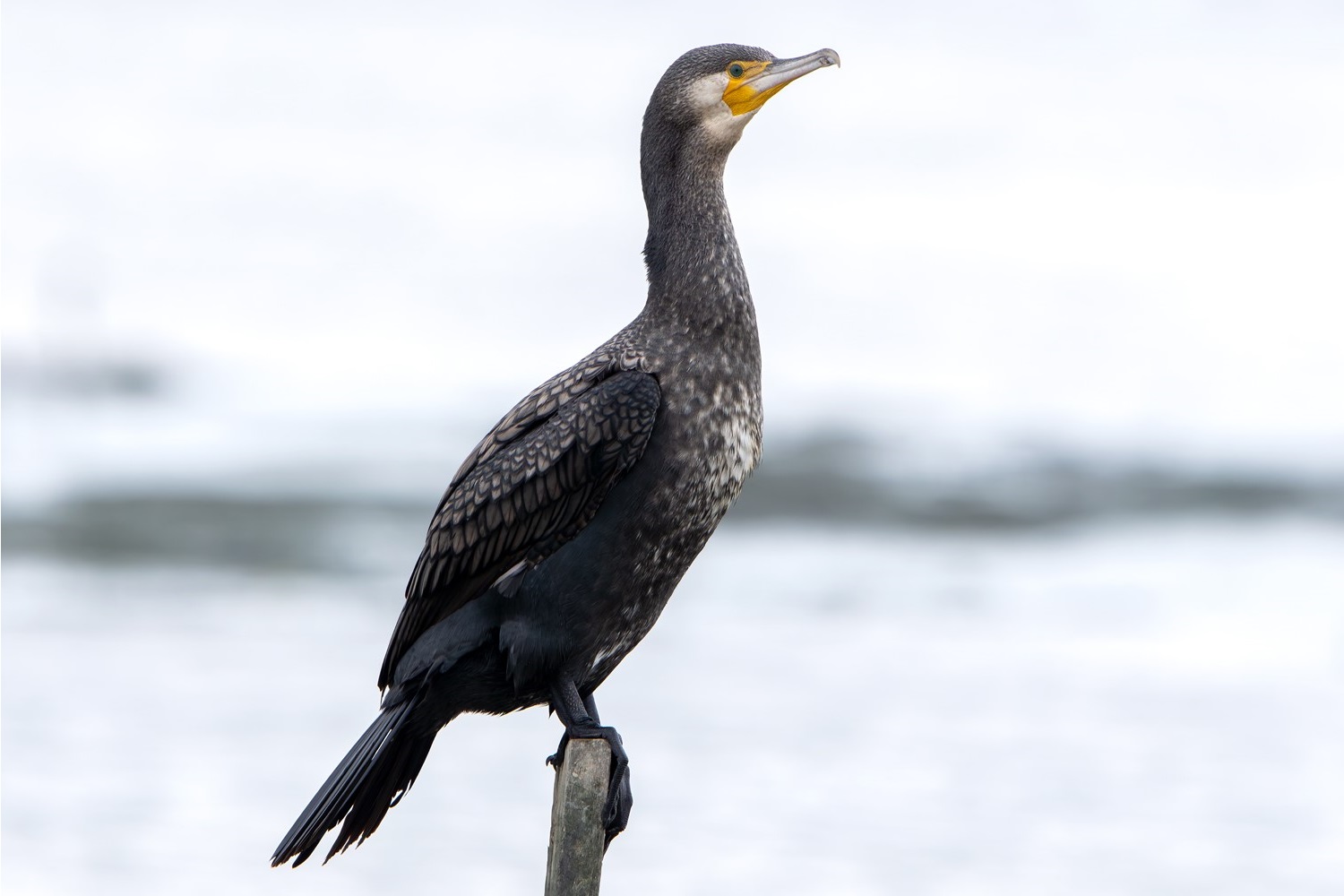Great Cormorant Phalacrocorax carbo 普通鸕鷀
Category I. Abundant winter visitor to Deep Bay area and both inshore and offshore waters.
IDENTIFICATION

Feb. 2007, James Lam. Adult, breeding plumage.
80-100 cm. Large somewhat ungainly birds with a sturdy, medium-length bill and stiff tail. Adults are all dark with yellow bare skin at base of lower mandible surrounded by white; in breeding plumage has white feathers on head and neck and white patch on thighs.

Mar. 2015, Michelle and Peter Wong. Immature.
Immatures have dark brown upperparts; underparts are often extensively pale on arrival in late autumn and become gradually darker during the course of the winter.

Dec. 2004, John and Jemi Holmes. Adult.
In flight carries out short bursts of gliding and the thick neck has a slight kink.
VOCALISATIONS
On the wintering grounds usually only vocal at diurnal or nocturnal roost sites.
DISTRIBUTION & HABITAT PREFERENCE
Most birds forage in Deep Bay, often in large flocks; however, a sizable proportion also feed in commercial fish ponds. Smaller numbers feed and roost in other coastal waters, though occasionally large numbers may opportunistically exploit prey sources in these areas.
OCCURRENCE
Figure 1 illustrates the trend of peak winter counts (usually roost counts) since the commencement of annual winter waterbird counts in 1979. During the 1980s most counts were no higher than 1,500, but in 1992/93 there was a substantial increase to 5,000 birds; since 1994/95 all counts have been higher than 6,000. There was a general increase to winter 2007/08 followed by a gradual decrease to approximately 7,000 in recent years. The highest count on record is 11,424 on 5 February 2005.
About 50% of the wintering population are present by mid-November and 75% by mid-December. Peak numbers are present by mid-January and remain until about mid-February in most years. A decline in numbers seems to commence in the second half of February, though it is gradual; the major departure usually occurs during March. The highest count in the first week of April is 607, but since 1999 there have been no three-figure counts in this month.
Great Cormorant usually occurs from the last week of September until the third week of April. No more than two birds have been recorded from May to August, and these summer records often refer to sick or injured birds.
Previous authors (Kershaw 1904, Vaughan and Jones 1913) noted it as a winter visitor to Deep Bay and Guangdong, and Macfarlane and Macdonald (1966) provided dates from 5 October to early May.
BEHAVIOUR, FORAGING & DIET
Piscivorous, foraging in offshore and inshore waters and in commercial fish ponds, where it takes Tilapia Oreochromis niloticus and Grey Mullet Mugil cephalus. Forages both in flocks and singly.
Roosts communally at favoured sites, which are usually occupied for many years. Birds usually depart the roost soon after sunrise in large groups, though may delay departure on cloudy days. Some birds may remain near foraging areas at daytime roosts, while small numbers may return immediately to the nocturnal roost.
Although birds flush relatively easily when foraging or at daytime roost in commercial fish pond areas, those at nocturnal roost (particularly Mai Po) are more tolerant of close approach.
RANGE & SYSTEMATICS
Discrete breeding populations are located in eastern Canada, western Greenland, northwest Europe (where some birds are resident), northern and eastern Europe east through the Black and Caspian Sea areas to Kazakhstan, Central Asia, northwest China, Mongolia, northeast China and Ussuriland. Winters to the south, with longer distance migrants in Asia wintering in India, Indochina and south China. Resident populations present in east and south Africa and Australasia (Hatch et al. 2020). In China breeds across the northern half of the country away from the Tibetan Plateau, and winters south of a line from Yunnan to Beijing (Liu and Chen 2020).
Five subspecies are recognised, of which P. c. sinensis occurs from central Europe east to India and China, including HK. P. c. hanedae is resident in Japan.
CONSERVATION STATUS
IUCN: Least Concern. Population trend increasing.
Figure 1.

Hatch, J. J., K. M. Brown, G. G. Hogan, R. D. Morris, J. Orta, E. F. J. Garcia, F. Jutglar, G. M. Kirwan, and P. F. D. Boesman (2020). Great Cormorant (Phalacrocorax carbo), version 1.0. In Birds of the World (S. M. Billerman, Editor). Cornell Lab of Ornithology, Ithaca, NY, USA. https://doi.org/10.2173/bow.grecor.01
Kershaw. J. C. (1904). List of birds of the Quangtung Coast, China. Ibis 1904: 235-248.
Liu, Y. and Y. H. Chen (eds) (2020). The CNG Field Guide to the Birds of China (in Chinese). Hunan Science and Technology Publication House, Changsha.
Macfarlane, A. M. and A. D. Macdonald, revised by Caunter, J. R. L. and A. M. Macfarlane (1966). An Annotated Check-list of the Birds of Hong Kong. Hong Kong Bird Watching Society, Hong Kong.
Vaughan, R. E. and K. H. Jones (1913). The birds of Hong Kong, Macao and the West River or Si Kiang in South-East China, with special reference to their nidification and seasonal movements. Ibis 1913: 17-76, 163-201, 351-384.

